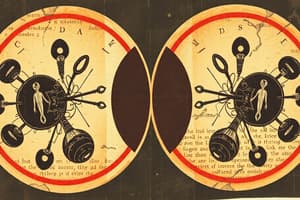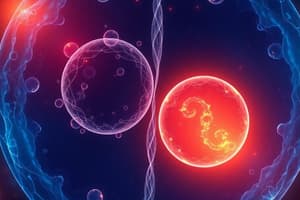Podcast
Questions and Answers
What is the primary purpose of meiosis?
What is the primary purpose of meiosis?
- Asexual reproduction
- Growth and repair
- Sexual reproduction (correct)
- Cell cycle regulation
How many divisions occur during meiosis?
How many divisions occur during meiosis?
- 1
- 3
- 4
- 2 (correct)
What is the result of meiosis in terms of the number of cells produced?
What is the result of meiosis in terms of the number of cells produced?
- 4 (correct)
- 8
- 2
- 6
Which of the following statements is accurate regarding genetic variation in meiosis?
Which of the following statements is accurate regarding genetic variation in meiosis?
At the end of meiosis, what is the chromosome number of the cells produced?
At the end of meiosis, what is the chromosome number of the cells produced?
What occurs during Anaphase I of meiosis?
What occurs during Anaphase I of meiosis?
What is the main purpose of independent assortment during meiosis?
What is the main purpose of independent assortment during meiosis?
What is produced at the end of Telophase II and Cytokinesis in meiosis?
What is produced at the end of Telophase II and Cytokinesis in meiosis?
Which stage of meiosis does DNA replication not occur after?
Which stage of meiosis does DNA replication not occur after?
What is a key difference between meiosis and mitosis regarding the outcome of cell division?
What is a key difference between meiosis and mitosis regarding the outcome of cell division?
Which phase of the cell cycle is the longest?
Which phase of the cell cycle is the longest?
What major event occurs during prophase?
What major event occurs during prophase?
During which stage do spindle fibers attach to the centromeres of chromosomes?
During which stage do spindle fibers attach to the centromeres of chromosomes?
What happens during the anaphase of mitosis?
What happens during the anaphase of mitosis?
Which sub-phase of interphase involves DNA replication?
Which sub-phase of interphase involves DNA replication?
What structure forms to help guide chromosomes during mitosis?
What structure forms to help guide chromosomes during mitosis?
What is the final result of mitosis and cytokinesis?
What is the final result of mitosis and cytokinesis?
What key event occurs during the checkpoint before anaphase?
What key event occurs during the checkpoint before anaphase?
What happens to sister chromatids during anaphase?
What happens to sister chromatids during anaphase?
In which stage do chromosomes become less compact and revert to chromatin?
In which stage do chromosomes become less compact and revert to chromatin?
How do animal cells achieve cytokinesis?
How do animal cells achieve cytokinesis?
What is a primary outcome of meiosis?
What is a primary outcome of meiosis?
Crossing over occurs in which stage of meiosis?
Crossing over occurs in which stage of meiosis?
Which of the following statements about mitosis and meiosis is true?
Which of the following statements about mitosis and meiosis is true?
Flashcards
Mitosis
Mitosis
The process by which a cell duplicates its chromosomes and divides into two identical nuclei.
Stages of Mitosis
Stages of Mitosis
There are five stages: Interphase, Prophase, Metaphase, Anaphase, Telophase.
Interphase
Interphase
The longest phase where the cell prepares for mitosis; DNA copies itself.
Prophase
Prophase
Signup and view all the flashcards
Metaphase
Metaphase
Signup and view all the flashcards
Anaphase
Anaphase
Signup and view all the flashcards
Telophase
Telophase
Signup and view all the flashcards
Cytokinesis
Cytokinesis
Signup and view all the flashcards
Independent Assortment
Independent Assortment
Signup and view all the flashcards
Telophase I and Cytokinesis
Telophase I and Cytokinesis
Signup and view all the flashcards
Prophase II
Prophase II
Signup and view all the flashcards
End Result of Meiosis
End Result of Meiosis
Signup and view all the flashcards
Purpose of Meiosis
Purpose of Meiosis
Signup and view all the flashcards
Number of Divisions in Meiosis
Number of Divisions in Meiosis
Signup and view all the flashcards
Cells Produced by Meiosis
Cells Produced by Meiosis
Signup and view all the flashcards
Genetic Variation in Meiosis
Genetic Variation in Meiosis
Signup and view all the flashcards
Chromosome Number in Meiosis
Chromosome Number in Meiosis
Signup and view all the flashcards
Checkpoint in Cell Division
Checkpoint in Cell Division
Signup and view all the flashcards
Prophase I in Meiosis
Prophase I in Meiosis
Signup and view all the flashcards
Metaphase I in Meiosis
Metaphase I in Meiosis
Signup and view all the flashcards
Chromatid Separation
Chromatid Separation
Signup and view all the flashcards
Study Notes
Mitosis and Meiosis
- Mitosis is a cell division process that produces two identical nuclei. It's used for growth, repair, and asexual reproduction.
- Meiosis is a cell division process that produces four genetically unique haploid cells (like sperm and egg cells). It's used for sexual reproduction and introduces diversity.
Stages of Mitosis
- Interphase: The cell spends most of its life here, DNA replicates and the cell grows.
- Prophase: Chromosomes condense, the nuclear membrane disappears, and spindle fibers form.
- Metaphase: Chromosomes line up in the middle of the cell.
- Anaphase: Sister chromatids are pulled apart to opposite ends of the cell.
- Telophase: New nuclear membranes form around each set of chromosomes and the cell begins to divide.
- Cytokinesis: The cell membrane pinches in and divides into two daughter cells. (This happens after Telophase).
Stages of Meiosis I
- Prophase I: Chromosomes condense and homologous chromosomes pair up to form tetrads. Crossing over occurs.
- Metaphase I: Homologous chromosome pairs line up at the metaphase plate. Independent assortment occurs.
- Anaphase I: Homologous chromosomes are pulled to opposite poles. Sister chromatids stay attached.
- Telophase I and Cytokinesis: The nuclear envelope may reform, the cell divides forming two haploid daughter cells.
Stages of Meiosis II
- Prophase II: Chromosomes condense again and the nuclear membrane breaks down. Spindle fibres form.
- Metaphase II: Chromosomes line up at the metaphase plate. Spindle fibers attach to centromeres.
- Anaphase II: Sister chromatids are pulled apart to opposite poles.
- Telophase II and Cytokinesis: Four genetically unique haploid cells result. Nuclear envelopes reform, and the cells divide.
Key Differences Between Mitosis and Meiosis
| Feature | Mitosis | Meiosis |
|---|---|---|
| Purpose | Growth, repair, asexual reproduction | Sexual reproduction |
| Number of Divisions | 1 | 2 |
| Number of Cells Produced | 2 | 4 |
| Genetic Variation | No | Yes (crossing over and independent assortment) |
| Chromosome Number | Diploid (2n) → Diploid (2n) | Diploid (2n) → Haploid (n) |
Studying That Suits You
Use AI to generate personalized quizzes and flashcards to suit your learning preferences.




